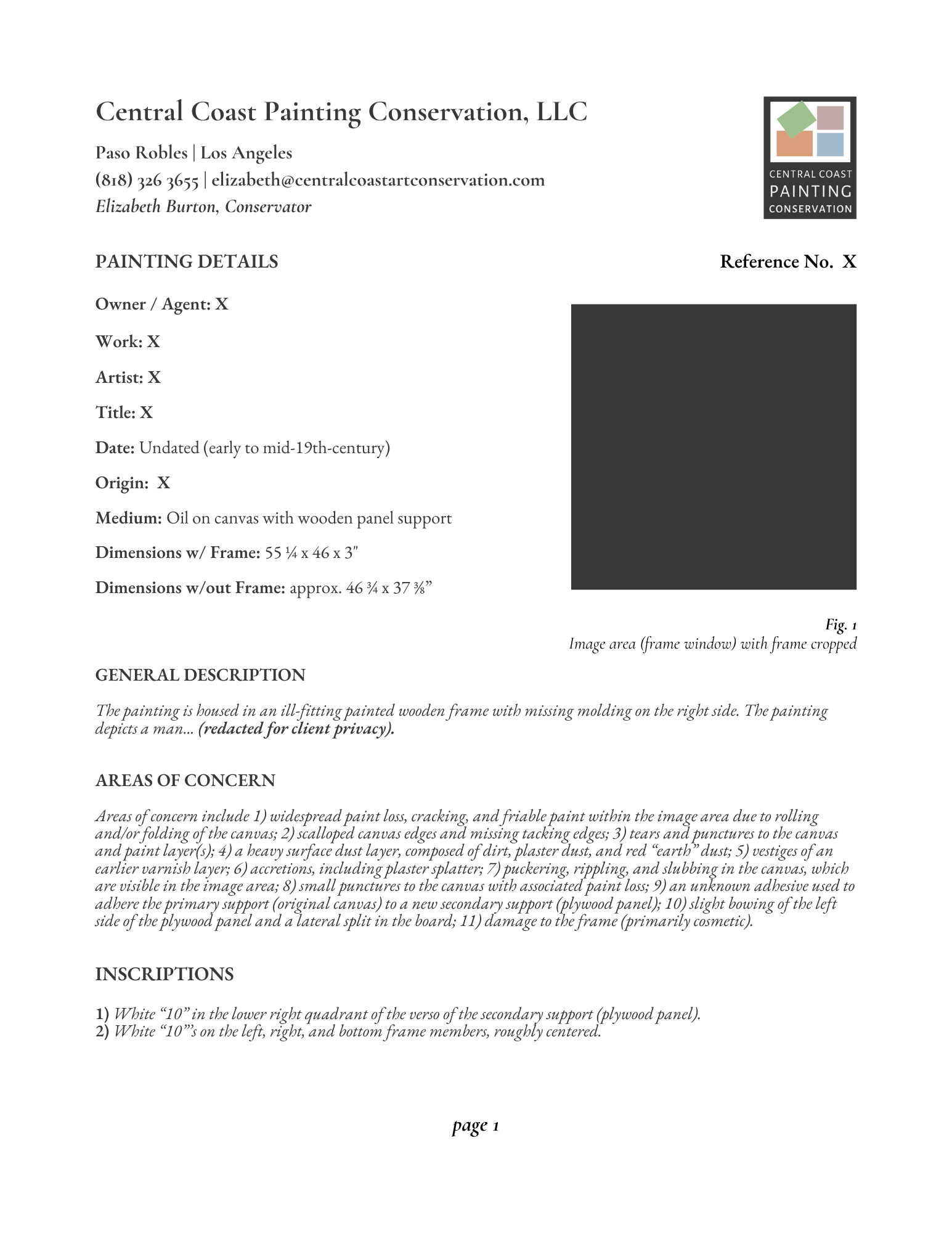Condition Assessment & Treatment Prior to Exhibition, Transport, or Auction
Prepare paintings for exhibition, auction, or travel.
Examine | Stabilize | Address Minor Aesthetic Issues
Prior to acquisition by your gallery, museum, or auction house, a collection or artist’s body of work may have been stored improperly or damaged during transit. The artist’s materials might have aged or evolved in unexpected ways. Previous conservation or restoration treatments may have deteriorated or discolored. After un-crating or un-rolling paintings you intend to exhibit, you might notice damage or suspect instability and be unsure of how to proceed.
This is why I offer group assessments and treatments (collection or exhibition-wide) prior to exhibition or auction. I assess the condition of each painting as an individual and as part of a collection, which allows me to determine which condition issues are isolated to one piece and which are a result of the artist’s technique or materials. I will help you determine which pieces can be stabilized and lightly cleaned before exhibition or auction, and which require more comprehensive conservation treatment. I will also help you determine which are safe to travel and am happy to work with your art handlers and other staff members.
David Hockney: 82 Portraits and 1 Still-life Exhibition, Apr 15–Jul 29, 2018, LACMA, BCAM, Level 3: Nathanson Gallery. Portraits assessed by Elizabeth Burton and Eugena Ordoñez of Painting Conservation & Research prior to exhibition in Los Angeles, California.
Reach out about your painting or upcoming exhibition.
Email: elizabeth@centralcoastartconservation.com
Cell: (818) 326 - 3655
Studios in Los Angeles and Paso Robles, California
Download a sample condition report.
Each conservator composes their reports slightly differently; we use the same terms but the formatting and depth of our reports vary. I write a separate report for each painting in a collection, lot, or exhibition. In my condition reports, I typically include an overview of the piece, a summary of its condition, and a condition assessment broken down by part (secondary support, primary support, ground layer, paint layer, coating, frame, etc.) or condition issue. I then attach a recommended treatment proposal if the painting could benefit from treatment.
Please find a sample condition report below; this report has been anonymized for client privacy, so you will not find images within the report. Photos taken during examination are always attached as an appendix.
What’s involved in collection-wide condition assessments and treatment planning?
Whether you're managing an artist’s estate acquisition, receiving pieces on loan, or preparing for an upcoming show, I am happy to examine, stabilize, and help present your paintings at their best while ensuring they are safe to exhibit.
-
We provide comprehensive condition reports for large collections of paintings. Whether you're preparing for an exhibition, auction, or acquiring an artist’s estate, our detailed reports include:
Visual Inspection: Thorough examination of each painting to document current condition.
Detailed Documentation: High-resolution photographs and written descriptions of any damage, wear, or previous restoration/conservation treatment.
Treatment Recommendations: Recommendations for stabilization and minor cosmetic improvements (light cleaning, filling, inpainting, etc.) prior to auction, sale, exhibition, or transport.
-
We offer professional advice on the exhibition readiness of pieces slated for sale, exhibition, or auction:
Assessment of Stability: Determining if a painting is stable enough for display.
Timely Interventions: Estimating the time required for necessary stabilizations and treatments.
Recommendations: Providing recommendations for safe display practices to minimize risk during the exhibition.
-
Ensuring paintings are stable and safe for display is absolutely essential. Our stabilization services cover:
Structural Repairs: Addressing any issues with the canvas or other substrate, stretcher, and frame to ensure stability.
Treating Mold or Pest Infestations: Removing residue and accretions that could damage the paint layer, substrate, or secondary support while limiting the risk of recurrence.
Preventive Measures: Applying temporary or permanent treatments to prevent further degradation during display.
Addressing Issues with the Paint Layer or Varnish: Stabilizing any flaking, tented, or friable paint at risk of loss.
-
Improperly stored or rolled canvases can suffer from distortion and damage. We will:
Careful Handling: Expert handling to minimize stress on the canvas and paint layer.
Professional Restretching: Using appropriate materials and techniques to resecure the canvas to its stretcher.
Attach Backing Boards: We will design and attach backing boards to prevent dust, damage during handling, and pest access.
Install Additional Supports: If needed, we will design and install additional supports like batting or foam inserts.
-
Over time, paintings can accumulate surface dirt and grime that dulls their appearance. Depending on your painting's condition, we might conduct:
Dry Surface Cleaning: Removal of dirt, dust, pest droppings, and superficial accretions.
Targeting Treatments: We might use chelating agents, solvents, or mechanical methods to remove or reduce the appearance of stubborn accretions, efflorescence, etc. We might also touch up the varnish in areas where it is uneven if that was not intended by the artist.
Contact us.
elizabeth@centralcoastartconservation.com
(818) 326 - 3655
(805) 728 - 0650
Paso Robles, California & Los Angeles, California
*currently accepting new clients with projects measuring less than 72 x 72”



